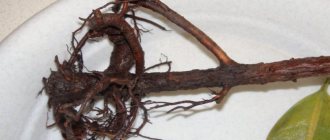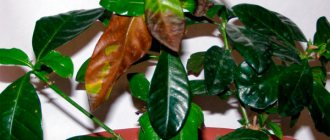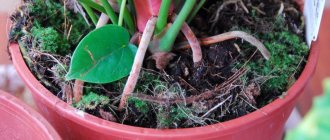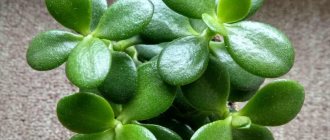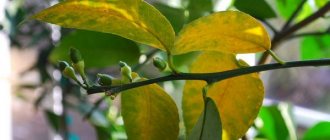Brief characteristics of the plant
The tree has another name - elastic (Ficus Elastica), belongs to the Mulberry family. In the 19th century it was grown for rubber production. Its homeland is India and the southern part of Indonesia from the islands of Sumatra and Java, where it grows into a tall tree, almost up to 30 meters, and is revered by local Buddhists as sacred, and in indoor conditions it rarely grows above 2 meters.
In its natural environment it is able to grow in the Mediterranean; in more northern latitudes it is grown only indoors, since it is not resistant to low temperatures.
The most famous species found in gardeners’ homes include:
- Belize. They have light pink or white patterns along the edges.
- Variegata. The leaves are thin, feathery, the streaks on the leaves are light...
- Robusta. The most common species with large leathery green leaves.
It is a tree with one trunk, without lateral branches, but in the process of growth branches and aerial roots appear on it, which, under the influence of warm and humid climatic conditions, reach the soil and form new trunks.
The leaves are quite large, reaching 30 cm, leathery, elongated, dark green, alternate. Very young leaves are brown in color.
The flowers are unremarkable, inconspicuous and are pollinated by pollinating insects, but flowers do not appear at home.
On the surface of the crown or stems you can sometimes see light spots with milky juice. If you touch them with exposed skin, you may experience dermatitis and allergic reactions, so when working with the plant you need to be careful and place the pot out of the reach of children and pets.
Ficus benjamina care. What is ficus benjamina
In northern Australia, the Philippines, China, India and some areas of Southeast Asia, the Benjamin tree is widespread. In the wild, the height of the trunk of an adult plant can reach 25 m, but the indoor counterpart is dwarf - no more than 2-3 m. The shoots are erect, and the stem is round. The leaves are smooth, glossy, thin-skinned and oblong-oval with a pointed apex. They are located alternately on the branches. Length is 6-13 cm, width – 2-6 cm.
The evergreen ornamental shrub has gray bark, but has sparse brown streaks. The Benjamin plant has an invasive root system that spreads not only deep into the earth, but also along its surface. The fruits are syconia, approximately 1.5 cm in diameter. Description of the fruits: red, paired, axillary, inedible, turning burgundy when ripe.
Varieties
Today, many varieties of this ficus are known, whose homeland is located in a vast region from China to northern Australia. All varieties of shrubs are good at purifying the air from microbes, because... it has bactericidal properties. Flower growers love ficus for its decorative properties. Before you start growing such a ficus, check out some popular varieties:
- Barok. The leaves are medium - about 4-6 cm. The shrub grows slowly, branches weakly; to obtain a lush plant, several cuttings are planted in a pot.
- Wendy (Wiandi). A small-leaved bush with leaves about 3 cm long. The leaf along the central vein is bent like a boat, and the tip is slightly torn off.
- Danielle. The size of the leaf plate is 8x3.5 cm, there is no waviness, the edges are even. With proper care, the annual growth is 30 cm per season. The leaves are dense, flat, dark green.
- Kinky. The bush is small-leaved, reaches 40 cm in adulthood. Leaf length is up to 4 cm, width – up to 2 cm.
- Monique. The leaves are large - 3-4 times longer than wide. The edges of the leaves are wavy, the shoots are drooping and thin. Grows quickly. A variegated form with light green spots is also common.
- Natasha (Natasja). Small-leaved bush. The area of the plates is about 3x1.5 cm, the color is grassy green, uniform. The shape of the leaves is oval with a sharp end and a depression in the center. It grows slowly.
- Naomi Gold. Large leaves, up to 6-7 cm long, slightly wavy edges, drooping shoots, thin.
- Nicole. Small-leaved. The leaves (up to 4 cm long) along the central vein are slightly bent like a boat, the edges are not wavy, the color is light green. Growth is moderate.
- Reginald. The leaves are golden green with spots along the midrib.
- Safari. A variegated bush with 3-4 cm leaves that are marbled in color. It grows slowly, and with a lack of lighting it begins to quickly lose its variegation.
- Starlight. The leaves are medium in size - about 4-6 cm. The color is rich green with a wide stripe of white along the edge - some leaves are almost white. Grows quickly.
- Exotica. The leaves are green, up to 3.5 cm wide, up to 8 cm long. The plate is soft and straight, the edges are slightly wavy. Grows quickly.
Basic rules for growing ficus
Flower growers often express the opinion that ficus is a rather capricious and fastidious crop to care for. However, this is not quite true.
Did you know? In India, the long roots of the rubber plant are used to create “living” bridges. This is done with the help of bamboo poles, along which the roots gradually “move” to the opposite bank. The length of such green bridges can reach 30 m, and they last a very long time, some for several centuries.
An evergreen plant requires compliance with the same growing rules as any other flower, namely:
Why do ficus leaves appear dry?
Ficus leaves drying out is a problem that anyone who has this indoor tree can face. If you care for it properly, it quickly grows up to three meters, but among flower growers there is a misconception that all representatives of the ficus family are too unpretentious and there is almost no need to care for them.
If you treat the flower this way, it will gradually begin to die: first, the tips of its leaves dry out, then yellow, brown or black spots appear on them. Eventually he will wither away completely. To prevent this disaster, you should follow basic care measures. If the tree begins to hurt, measures must be taken immediately.
How to water
In the summer you need to water the plant quite often, but the main thing is not to overdo it so that the soil has time to dry out. As a rule, the plant signals a lack of water by drooping leaves. It is also recommended to spray it (daily or less often) or wipe it with a soft damp cloth, sponge, or cotton pad. You can also bathe the flower directly in the shower, only the water temperature should be about 20 degrees.
In winter, most plants require less intensive watering, including spathiphyllum: the leaves turn black, become covered with brown spots, or dry out in the cold season, often precisely because of excess moisture. In winter, the flowers are at a dormant stage, so rare watering and no spraying for 2-3 weeks will benefit them.
Why do ficus leaves turn black and dry?
The culture has a number of requirements for the grower, the violation of which may be the reason why the ficus leaves turn black. Let's find out more about this.
Natural
Flowers, like all living things, experience stress. The plant shows this by its appearance. If you just bought a flower and brought it home, then for the first few days it will drop dry leaves. In this situation, you need to give the ficus time; after 7-10 days the foliage will stop falling and the crop will begin to grow green.
Leaf blades may also fall off with the arrival of autumn or winter. After all, ficuses are the same trees, only indoors and in a smaller form. In this case, the plant does not need resuscitation.
Unnatural
In the following cases, the negative process occurs due to the mistakes of the grower. These reasons are worth thinking about if the ficus begins to lose leaves in the summer or spring season.
Excessive soil moisture
There is no doubt that this is the most common cause of blackening of ficus leaves.
It is known that these plants love moist soil and should not be allowed to dry out. Knowing this, many inexperienced gardeners try to water their pets more abundantly, especially on hot days. But it is important to remember - the ficus should be watered only when the earthen lump in the pot dries to a depth of about 5 cm! Check this with your finger, a special stick, or even by eye, if experience allows. Excessive flooding is especially dangerous in the winter months, when the ficus rests and the life processes in its tissues slow down. In addition, as a rule, the pot with the plant is on the windowsill, and in winter it is always cooler here than in the room as a whole. Excess moisture in a cooled earthen coma is almost a guarantee that the edges of the leaves will begin to turn black.
This is interesting: What fertilizers should be used for orchids?
Important! When talking about excessive watering, you need to understand that it often leads to consequences such as root rotting and the occurrence of various fungal diseases. They are much more dangerous than just excess moisture in the soil.
How to understand that the edges of ficus leaves turn black precisely because of watering:
- – the soil does not dry out for a long time in the top layer;
- – the leaf itself quickly loses turgor and becomes lethargic;
- – the blackened area is soft, slightly moist to the touch if you rub it with your fingers;
- – the smell of the soil becomes unpleasant and musty.
Cold drafts
A relatively rare cause, although it occurs regularly in autumn and winter. When there is a draft, usually only part of the leaves of the crown turn black, but the process occurs rapidly, sometimes within several hours. If the blackness has not spread to a large area of the leaf, it can be saved by removing the cause of the draft. The edges of the blackened areas do not have clear boundaries, they seem to be blurred.
Sunburn
The picture is similar in appearance to the previous one, only the color of the affected areas during a sunburn is initially light brown, almost yellow. A similar situation arises if the plant is exposed to the sun, under direct sunlight. This moment is especially dangerous for ficus trees that are accustomed to standing in a shady place.
Excessively dry air
And this reason occurs often. Ficuses love humid air; it is difficult for them to put up with the dry atmosphere of our apartments. This is especially true in the winter months, when heating radiators are turned on in residential areas. It often happens that a ficus, standing on a windowsill, hangs over the heating radiator with several of its leaves, and then it is these leaves that begin to turn black. The picture of the lesion in this case differs from that described above, namely:
- – the color of the darkened stripe is not so black - it is rather brown;
- – the affected area is dry and flaky to the touch, easily rubbed into powder with your fingers;
- – there is no general decrease in the turgor of the leaf plate, the leaf remains elastic.
Lack of useful components in the soil
If you carefully follow the watering rules, and the ficus leaves still darken, then perhaps the problem is a lack of fertilizer.
Therefore, it is worth carefully familiarizing yourself with the organization of the plant feeding procedure:
- In summer and spring, ficus needs mineral and organic fertilizers. You can feed it with such products as “Ideal”, “Kemira”, “Giant”, “Rainbow”, “Palma”, “Gumisol”. It is worth fertilizing the flowerpot with a solution of the listed products, strictly following the instructions. Feeding frequency is every 10–14 days.
- In autumn, the amount of fertilizing is reduced to 1 time per month.
- In winter, the crop goes dormant, so there is no need to fertilize it.
The reason for the darkening of leaf edges may be a lack of nitrogen in the soil, especially during the period of active growth of the ficus - in spring and summer. In autumn and winter, on the contrary, you should stop applying nitrogen-containing products.
Important! After transplantation, the ficus does not need to be fed for 2 months, since the substrate contains enough nutrients to ensure the normal functioning of the flower.
Low quality of irrigation water
It is strictly forbidden to water ficus plants with cold water, especially on hot days, as this can lead to so-called root burns. Due to such watering, the roots of the crop become sick, and this is externally expressed by the blackened edges of the foliage. The optimal water temperature for humidification is +20°C. In addition, the liquid must be filtered and infused.
Excess of fertilizers in the soil, especially nitrogen
Overfeeding the ficus can lead to massive darkening, and subsequently to blackening of the leaves.
A distinctive feature is that blackness does not appear at the edges, but immediately on the entire sheet plate. If the process is just beginning, and the leaves have withered, and you understand what the mistake is, you need to wash the earthen lump with plenty of water, subsequently drying it thoroughly. Thus, in order to avoid blackening of ficus leaves, the following important requirements must be met:
- – water regularly, on time, observing the necessary standards;
- – monitor the quality of the soil in the pot, check the drainage;
- – maintain the required level of air humidity near the ficus;
- – pay attention to the quality of fertilizing;
- – make sure that the flower is not exposed to a draft or exposed to direct sunlight.
If these conditions are met, the leaves of your ficus should not turn black.
Errors in care as the cause of ficus leaves falling
Often the cause of ficus leaves falling is a violation of the rules of care. Despite the fact that this plant is quite picky, it needs proper watering, proper replanting and a certain microclimate.
Incorrect living conditions: lighting, temperature, humidity
Ficuses react sharply to temperature changes. As soon as the air temperature drops below +16 °C, the leaves, especially the lower ones, immediately begin to turn yellow and fall off. In addition, drafts and open windows can cause “baldness” of the stem.
Ficus does not like drafts
Important! Any changes in the microclimate (lower or higher humidity, light or temperature) can cause leaves to fall. It is undesirable to make any changes to the usual existence of the ficus.
At too high temperatures, when the thermometer rises above +30 °C, the leaves become weak, change color and eventually fall off. Therefore, it is very important to focus on the characteristics of the selected variety; their care requirements may vary slightly.
Ficus plants grow well if the air in the room is sufficiently humid. When it is too dry, the risk of foliage falling increases significantly. Especially if the pot is on the windowsill next to heating devices, or the weather outside is too hot.
Humidifier for ficus
In order to adjust the humidity level, you can place a container of water near the flower or use special devices - air humidifiers.
If your ficus has leaves of a uniform, rich green color, then it can easily grow in partial shade. But varieties with variegated leaves need good lighting. The higher it is, the brighter and more cheerful the plant will look.
Very often, it is the lack of light that causes the plant to wither, lose elasticity and dry out. Almost any type of ficus will grow poorly in a dark place, even with good watering and fertilizing.
Mistakes when watering
Watering too much can also cause your ficus to lose its leaves. But if there is too little water and the soil dries out, then this will not serve health. When the soil is constantly wet, the roots in it become vulnerable to various diseases. Rot or mold may appear. This can be determined by the characteristic unpleasant odor that begins to emanate from the ground. Another difficulty lies in the fact that the roots are hidden by soil and cannot be seen. You can determine the disease by the milky sap - to do this, pinch off part of the shoot - if the sap comes out brown instead of white, it’s time to start treatment. If the leaves have fallen from only one branch, then it is better to remove it.
How to help ficus:
- Stop watering.
- If no improvement is observed over the next few days, you will have to remove the plant from the pot and rinse the roots with warm water, first shaking them off the soil.
- If affected roots with signs of disease are present, they must be cut off with pre-disinfected sharp scissors.
- The cut areas must be powdered with crushed activated carbon tablets.
- Transplant the ficus into fresh soil and then leave it alone for 2-3 weeks, without even watering.
Sometimes the leaves begin to wrinkle. This may indicate insufficient hydration of the plant. Spraying will help correct the situation.
Incorrect transplant
As we said above, ficus trees do not like to change their place of residence and do not tolerate any interference in their measured existence. Even a forced transplant is stressful for a plant, to which it immediately responds accordingly.
If a flower has grown out of its pot and requires expanding its area, then it needs to be replanted as carefully as possible - literally by moving it to a new place along with the previous lump of earth. The remaining space is filled with moistened soil. After this, watering is completely excluded for 7-10 days. There is no need to water the plant immediately after transplanting.
Sometimes it happens that, once in a new pot, a flower begins to actively shed its leaves. It is important to understand what he didn’t like:
- An oversized pot was taken, which is more than 4 cm wider than the previous one.
- The ground was abundantly watered.
In both cases, you will have to replant the ficus, taking into account the mistakes made. If everything was carried out according to the rules, then it is quite possible that leaf fall is a reaction to stress. You need to wait for the plant to adapt. This may take from 1 to 4 months.
Lack of micro- and macroelements
As a result of a deficiency of macro- and microelements, plants develop small leaves. For the same reason, they may begin to fall off.
If the soil is poor and depleted, then you need to organize proper feeding or transplant the flower into new soil.
Indoor flowers respond best to nitrogen fertilizers. They cause vigorous growth of green mass. With a lack of magnesium, the color of the leaves begins to fade and change to yellow. In this case, magnesium sulfate, potassium magnesia or dolomite flour can be used as a fertilizer. Some gardeners prefer to use specialized preparations, for example, Emerald. If the iron content in the soil is low, it is necessary to add Ferrovit or iron chelate to it, otherwise the leaves will fall off.
Leaf Rescuer
Attention! All fertilizers should be applied only to well-moistened soil. On the first day, abundant watering is carried out and only on the third or fourth day can you start feeding. Otherwise, you risk burning the root system.
If the ficus looks too weak, then the concentration of the drug recommended by the manufacturer must be halved.
“Maintenance therapy” for houseplants should be carried out in March-September, when the development process is underway. With the onset of winter, the ficus enters a state of dormancy, the intensity of absorption of nutrients by the roots decreases, and photosynthesis ends.
Many tree varieties, primarily Ficus Benjamin, regularly shed their leaves when the concentration of macro- and microelements in the soil decreases. If all other reasons for this behavior are excluded, then apply a specialized fertilizer intended for home ornamental plants. It is best to take care of sufficient nutrition for the flower in advance and feed it twice a year during the period of active growth.
Attention! When you transplant a ficus into a new pot and use ready-made soil, you do not need to add additional fertilizing - the specialized soil already contains a sufficient amount of useful substances. The first fertilizers can be used to enrich the plant no earlier than after 1-1.5 months. If you do this right away, you can easily burn the root system.
To ensure that your ficus grows well and turns green, make it a rule to apply fertilizers in spring and summer. This is done twice a month; it is best to alternate the composition of nutrients. Mandatory macroelements are nitrogen, potassium, phosphorus, magnesium and the biogenic element iron.
To make your work easier, it is best to purchase ready-made drugs, for example, Ideal or Palma.
An interesting video about caring for rubber-bearing ficus (watering, fertilizing, analyzing why the leaves fall, dry and turn yellow):
Diseases
Improper care can cause illness
In the list of common reasons why ficus trees shed leaves, the first number is emerging infections and care problems. In most cases they are easily removable. Measures taken in time make it possible to revive an indoor flower.
Avitaminosis
Lack of nutritional components in the soil where the ficus grows leads to shredding of the leaves. With inadequate feeding and improper care, when the indoor climate is too dry and the temperature is too high, the situation gets worse: the ficus leaves become smaller, you can see how they droop and dry out, which often leads to falling off. If there is insufficient fertilizer, the ficus usually begins to fall off from the bottom up.
Rot
When yellow spots appear on the leaves of a ficus, we can talk about rot on the root system of the plant, which has appeared due to excessive watering. An excess of liquid, which does not have time to evaporate from the soil layer in the pot, leads to rotting, yellowing, falling leaves and death.
Hypervitaminosis
Oversaturation of the soil with fertilizers also adversely affects the quality of ficus foliage. For these reasons, brown spots appear on the leaves - specks; over time, the foliage turns black and flies off. Fall occurs randomly.
Fungal infections
Signs of rot and sooty fungus are black or red spots of mold, which are located on the outer part of the leaf blade and may be present on the stem of the plant. Ficus leaves affected by a fungal infection begin to turn yellow and fall off. A fungal disease that is not detected in a timely manner becomes a frequent cause of plant death, and in a short time.
This is interesting: Nectarine - planting and growing, nectarine care in the garden, propagation and pruning of peach hybrid
Ficus benjamina leaves are falling. Ficus benjamina - leaves turn yellow and fall off, what to do
If the leaves of the ficus benjamina turn yellow and fall off, few people know what to do. This is the main question that puzzles flower growers who have this beautiful, decorative foliage flower at home. And there is a plant in almost every home and in many offices, cafes, and shopping centers. Its external qualities are excellent; an expressive, laconic plant fits into every interior. However, the flower will need careful care, which will ensure its full growth and development. The most popular problem - yellowing and falling leaves - is discussed in detail below.
Ficus benjamina: leaves turn yellow and fall off, what to do
To eliminate the problem of yellowed leaves, you need to find the cause of this phenomenon. Below are several options for why ficus leaves turn yellow and fall off:
- improper watering. This is the most common mistake gardeners make, due to which the leaves can turn yellow and fall off. For each specific plant, you need to calculate the amount of water it needs. This will depend on the age, size of the Ficus Benjamina, its variety and growing conditions. Excessive watering threatens that the plant will get sick and its roots will begin to rot. A lack of liquid is dangerous because the ficus will try to retain moisture in the roots and stem and will shed its leaves as not the most important element. After 5-6 waterings, the flower will recover, but the new crown will not turn green soon. To determine the correct watering time, you need to evaluate the soil moisture. It should be allowed to dry by 1.5 cm in young plants and up to 3 cm in adults. The water should be soft, settled at room temperature;
Discarded yellow leaves of ficus benjamina
- non-compliance with temperature conditions. This problem can easily be avoided, since the flower feels wonderful at a standard room temperature of 20-25 °C. If the temperature crosses the lower limit, the roots become overcooled, and as a result, the leaves begin to dry out, turn yellow and fall off. If there is a strong drop in temperature, the tree will die;
- air humidity is too low. Ficus benjamina, like the broadleaf ficus, does not tolerate dry air. To solve this issue, you can simply spray the flower from a distance. If there is a humidifier in the apartment near the flower pots, this is ideal;
- non-compliance with the rules for transplanting ficus. Transplantation should be done once every 2 years. During this time, the root system completely envelops the earthen ball, and the plant needs a larger container in which it will continue to develop. Transplantation should be carried out by transshipment, and the roots should not be damaged;
- soil depletion. This problem occurs if a transplant has not been performed for a long time. To prevent this from happening, the plant must be fed with special fertilizers. It is also recommended to add fresh nutritious soil to the ficus pot. These simple recommendations will help cope with the lack of vitamins and minerals.
Pests
Insect pests cause many plant diseases. Below are the main pests and ways to combat them:
Shield.
- This pest sucks sap from plants, which leads to slow growth and the appearance of brown spots on the leaves, mainly on the inside. The scale leaves a sticky coating, which becomes a favorable environment for the development of sooty fungus.
How to save Ficus? You need to fight scale insects in the following way: dip your hands in a soapy solution and clean the leaves from sticky residue, and then treat the ficus with Actellik solution for three weeks.
The following photo shows a scale insect on a Ficus:
You can learn more about how to save a flower from scale in the video below:
Spider mite. It can be of two types: red and yellow. However, the damage they cause is the same - the mite on the Ficus bites into the leaves and sucks the juice from them. It leaves a gray coating with a brown tint on the leaves. If you find cobwebs on a flower, this indicates that it is infected with spider mites.
Look further at the photo of spider mites on Ficus:
How to treat Ficus? There is a folk method of combating spider mites - spray the flower with garlic infusion. Aphid. It is not difficult to determine whether a leaf is affected by aphids: they lose color and curl because the aphids feed on their sap.
You may find aphid colonies on the undersides of leaves. Removing aphids is quite simple; you don’t even need chemicals; this is done with a soap solution (10 g of soap per 1 liter of water).
Folk methods of struggle are spraying with a decoction of onion, wormwood or dandelion peels. Midges. They appear in winter from excess moisture and damage the root system of the flower.
What to do if there are midges in Ficus? To get rid of them, you need to transplant the flower into new soil and be sure to clean the roots, and then treat the flower with a special chemical solution against midges.
Proper care and timely prevention are the key to the health of your flower. Observe the temperature and light conditions, water, spray and fertilize the plant on time, replant it regularly, clean the pot tray and choose the right place for it.
Treatment options
It is not enough to know why the ficus dries out; it is important to take urgent measures to save it. The first and most effective way to get rid of dry leaves is to follow the recommendations mentioned above. By carrying out prevention, you will improve the general condition of the plant and provide it with proper care.
In addition, you can use the following tips:
- Water the ficus with water whose temperature is 50 degrees Celsius, neither higher nor lower. This will help improve the growth of the flower and prevent its leaves from drying out.
- Water as needed. In other words, inspect the soil and only then water the ficus. If the soil is moist enough, no watering is required.
- Spray with boiled water.
- Try not to create drafts in the apartment.
- Buy chemical insecticides if you notice the presence of pests living in the plant.
These are all the basic rules, following which you can rid yourself of problems with ficus once and for all. In a short period of time you can grow an amazing tree, which is a symbol of family well-being and happiness. It will be absolutely healthy and blooming, so you will have to forget about dry leaves.
It is not surprising that ficus is loved by so many housewives, because this indoor plant attracts them not only with its appearance, but also because it does not require scrupulous care.
Features of plant care
In order to eliminate many diseases and ensure the proper development of the plant, it is worth following some care recommendations. The most important conditions are:
- lighting;
- watering;
- feeding;
- temperature regime;
- humidity.
Basically, all types of ficus require a large amount of daylight. Therefore, their placement should be done in well-lit areas.
Plant types that are dark green in color require, on the contrary, more shaded areas.
Exposure to direct sunlight has a negative impact on their well-being. For the winter period, it is worth providing additional lighting for ficuses.
The most optimal daylight hours for a given crop should last at least 12 hours.
The intensity of watering depends on the time of year. On hot summer days, plenty of regular moisture will be required. But you should make sure that the soil dries out during the break.
Healthy ficus foliage
In winter, there is no need for frequent and abundant watering; on the contrary, if too much waterlogging, the ficus may become diseased.
The plant requires feeding only during the period of maximum development (March-September). The regularity of adding useful components should not exceed once every two weeks.
It is also worth paying attention to the fact that the fertilizer used should include nitrogen-based fertilizers.
Ficus is a plant that loves warmth, so the maximum permissible temperature can reach 30˚C, but the minimum should not fall below 10˚C.
High air humidity can only have a beneficial effect on the development of the plant. But this condition is not as important as the previous ones.
It is enough to spray the foliage with water from a spray bottle every week. In addition, it is worth wiping the smooth foliage regularly with a damp sponge to remove settled dust particles.
To ensure the full development of the plant, it is necessary to regularly water, fertilize, and monitor the temperature and humidity conditions.
Prevention
In order to avoid blackening of leaves, you should follow a few simple rules:
- The flower pot must have a drainage system;
- During hot summer days, daily spraying can be carried out;
- Place the pot with the plant on a windowsill located on the east side, which will prevent burns from direct sunlight;
- Plant ficus in soil that consists of sand, leaf soil, and peat in equal proportions;
- Regularly feed the soil with the necessary fertilizers.
This is interesting: Under what conditions do cacti bloom? Serkti for beginner gardeners
Thanks to these simple steps, the appearance of blackness on ficus leaves is practically eliminated.
In order to prevent blackening of the leaves, you should pay attention to the proper care and placement of the plant.
What to do if the ficus leaves turn black or darken? Start by finding out the reason. Excessive moisture is a common cause of various flower problems. This, in particular, may explain why ficus leaves turn black. Most often, the root system begins to rot; it can no longer absorb nutrients from the soil, so the foliage becomes sick and dies. If this happens, there are two options to save the plant. You can try replanting a ficus whose leaves are darkening. The process involves washing off the soil from the root system and carrying out sanitation. It is important to cut off all rotten areas to healthy tissue. If the damage is very serious, we recommend placing the roots in a fungicide solution. It is best to use a product that is specifically designed to combat root rot. Magnicur Energy is very effective. We recommend using a solution of the same product for the next few waterings. If the rhizome is completely damaged and there is no way to save it, you should use a cutting for propagation. In the future, when growing a young plant, you need to adjust the care. When preparing the soil for ficus, you can only use deoxidized peat, because the described plant prefers a substrate with a neutral reaction. Also, you should not plant this plant in a clay container. This can also negatively affect the root system. We recommend adding humus to the substrate. This product will act as both a ripper and as a top dressing. It is important to disinfect the soil before planting. This can be done by frying the substrate in the oven or watering it with a manganese solution. Infection in the soil can also cause leaves to turn black or develop dark spots. Dry air is most dangerous in winter when the heating is on. To prevent the ficus leaves from turning black or starting to dry out and fall off, you should place the flower away from radiators, radiators and heaters. You can cover the battery with a thick cloth. To protect against sunburn in the summer, a screen that is attached to the glass is useful. You can simply use paper or parchment, which should be placed in front of the crown. Sometimes a cold burn of the roots may occur. This happens if you pour very cold water on your ficus. In the described case, the foliage loses turgor and a black border appears along the edges. The condition of the foliage can be affected not only by a lack of fertilizers, but also by their excess. This is especially true for nitrogen-containing products. For such a reason, it is typical that blackening spreads across the entire leaf at once. You can try to save the flower by removing it from the pot and washing the rhizome. Next, replant in properly selected soil, do not fertilize in the near future. Another reason for the blackening of leaves of a completely different kind is the development of sooty fungus. This parasite appears on the crown due to attack by pests, such as scale insects. In this case, you need to start by eliminating pests and also wash the plant.
While watching the video you will learn about growing ficus.
Ficus is a unique beautiful plant that will decorate any home. Caring for it is quite simple. You can often see the appearance of blackness on the leaves, which subsequently leads to their falling and the death of the entire plant.
In order to prevent this problem, you should pay attention to proper flower care and regular fertilization and watering.
How to save ficus
How to revive a ficus that has begun to rapidly lose leaves? This process begins due to many reasons: a sudden change of location, draft, cold and errors in care, or even lack of care. With a regular lack of lighting, too dry air or waterlogging, “leaf fall” and rapid death of the plant will not take long, so measures should be taken immediately.
If the leaf falls off in large quantities, the first step is to spray the Benjamin ficus with the maintenance drug Epin. Restoring the viability of a plant directly depends on the reasons that caused its disease. Sometimes it is possible to restore the beauty and healthy appearance of a rubber plant with the help of basic measures, without even resorting to scrupulous replanting and lengthy processing.
The main conditions for the normal life of a tree are diffused light, moderate and timely watering, air humidity from 50 to 70 percent and spraying. The soil should dry out a little between water procedures, and the need for watering can be easily determined by checking the condition of the soil in the pot. If its top layer has dried out a little (by two to three centimeters), it’s time to water the ficus. You cannot frequently move the pot from place to place, as this will cause leaf fall to become regular, and it may happen that the plant completely loses its foliage, without even suffering from fungal diseases.
The scorching sun is contraindicated for ficus plants. It would be a mistake to believe that if we are talking about a tropical plant, then it will not care about sunlight. The foliage of most rubber plants is dense and thick, which means it contains a sufficient amount of moisture (which cannot be said about tenacious cacti) and will suffer from its lack.
If a gardener gets a tree with a classic, dark green foliage color, such varieties are more unpretentious in care and can acclimatize well even under conditions of regular shading. As for bright variegated leaves, the situation with them is much more complicated: they are capricious, and if the owner does not pay special attention to them, they can quickly die. Variegated varieties are especially sensitive to lack of lighting: they can wither even if they are placed in the shade for a short time.
Air temperature is no less important. In summer, its optimal values are from +25 to 30C, and if it rises, the plant should not only be watered and shaded, but also sprayed. Heat can also cause leaf drying and subsequent rubber disease. In the cold season, the roots should not be allowed to overcool. If possible, it is better to place the pot on a stand or windowsill, wrapping it in a warm cloth. The room temperature should not be allowed to drop below +15C.
This is interesting: How to prune cherries correctly - a diagram for pruning the plant in the fall: a detailed diagram for beginners
So, the issue of resuscitating a fading pet can be resolved by following the usual and simple measures to care for it, as well as choosing a permanent and most suitable growing location, with diffused light and the absence of drafts.
Optimal conditions for ficus resuscitation
The tree can also be removed in more severe cases. It also happens that, due to total leaf fall, only the trunk remains. It is necessary to check how much vitality is still left in it: if it remains flexible and has not had time to dry out, there is a chance to save the rubber plant. If rot and plaque appears on the soil in the root zone of the trunk, you should also not despair: this will require immediate replanting with a scrupulous examination of the root system for damage by nematode pests.
If there are small light lumps on the roots, this is the result of parasite activity. Treating the roots with insecticides and disinfectants will help. An ordinary weak solution of potassium permanganate helps a lot.
The wilting of a tree can be caused by the intensive growth of its root system, which simply no longer fits into the previous container. A transplant will also help here, and the new container should be two to three centimeters larger than the previous one. There is no need to use a pot that is too large.
After transplanting, regular watering will be required, but not earlier than after two days. Fertilizing is carried out only after reliable rooting, after a month. As for the intensity of leaf fall, in autumn, a loss of about twenty percent is the norm, and it is not associated with any diseases or errors in care.
A typical mistake of a gardener who wants to revive a ficus is the desire to feed it as much as possible. This cannot be done, since a weakened plant is simply not able to absorb the complex substances contained in mineral fertilizers, and they will only harm it.
Experienced plant growers on numerous forums are happy to share their experience of caring for the most “difficult” patients among the ficus plants they received. In their practice, there are cases when they had to deal with an almost flown-off flower, on which no more than five leaves remained. For the dried out plant, the soil was completely changed to a suitable nutrient composition and the roots were washed in a manganese solution.
If there were signs of rotting, the diseased roots were removed with sharp pruning shears and sprinkled with wood ash. After transplantation, they added a little fertilizer, placed the flower in a suitable place and shaded it so that the bright sun did not shine on it. Of course, the watering and spraying scheme was adjusted. In most cases, “neglected” rubber plants came to life after a few weeks and began to produce new healthy leaves.
As practice shows, it is quite possible to revive a ficus - even in a very “neglected” state, but in order not to resort to such measures, it is best to properly care for it and take care of it. Then he will not get sick and will always delight the owner with his healthy appearance.
Useful care tips
Experienced gardeners share some secrets of growing ficus trees:
- You cannot move the flowerpot from place to place - it does not like to be touched, moved, or disturbed. The plant’s response to such actions will be its depression, dull stature, and blackening of the foliage.
- When caring for foliage, be very careful: the milky sap of ficus contains toxic substances. Also make sure that the leaves of the flowerpot are not chewed by children or animals.
- Do not buy a ficus in autumn or winter: at this time it will take root very poorly in a new place.
- Inexperienced gardeners believe that the larger the plant, the better. But this is not so: the adaptation of an adult plant to new living conditions will be long and complex.
- Check the plant's root system regularly. To do this, just look at the roots through the drainage hole: if they turn black or brown, then the crop is sick.
As you can see, the ficus is not as capricious as they say. However, like all indoor plants, it requires care, which will not take much time and effort, but its bright green foliage will always please the eye.
